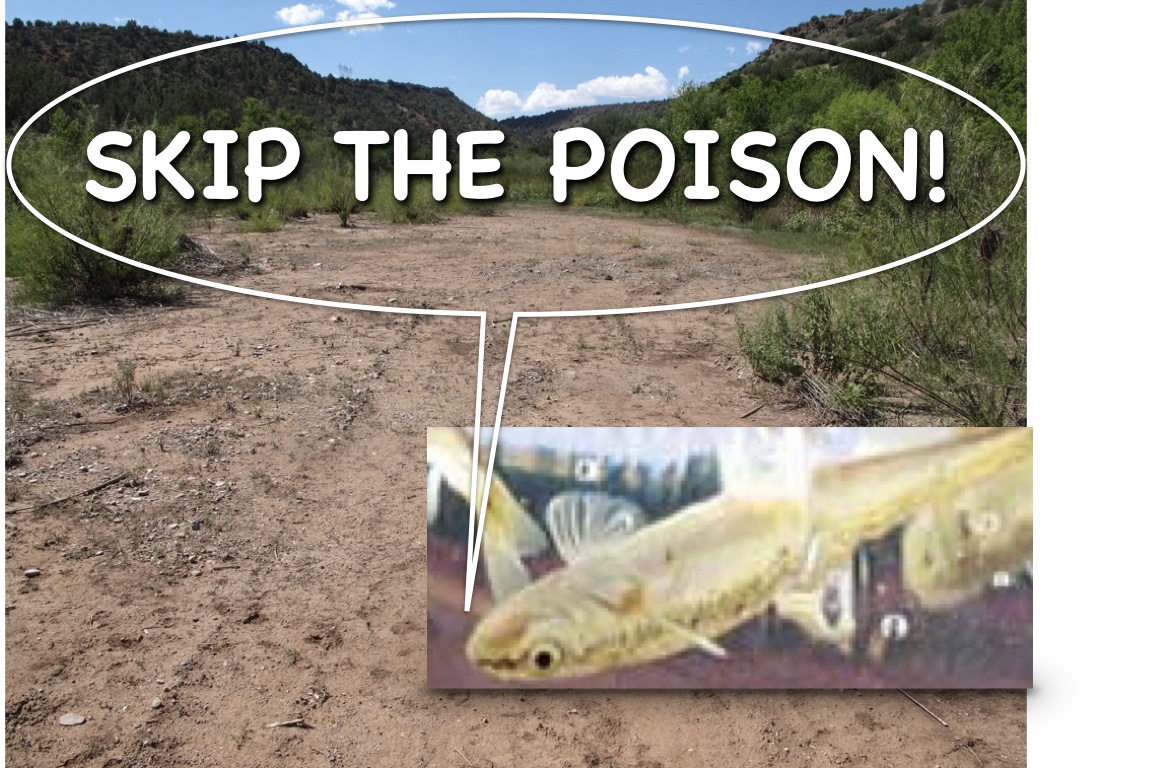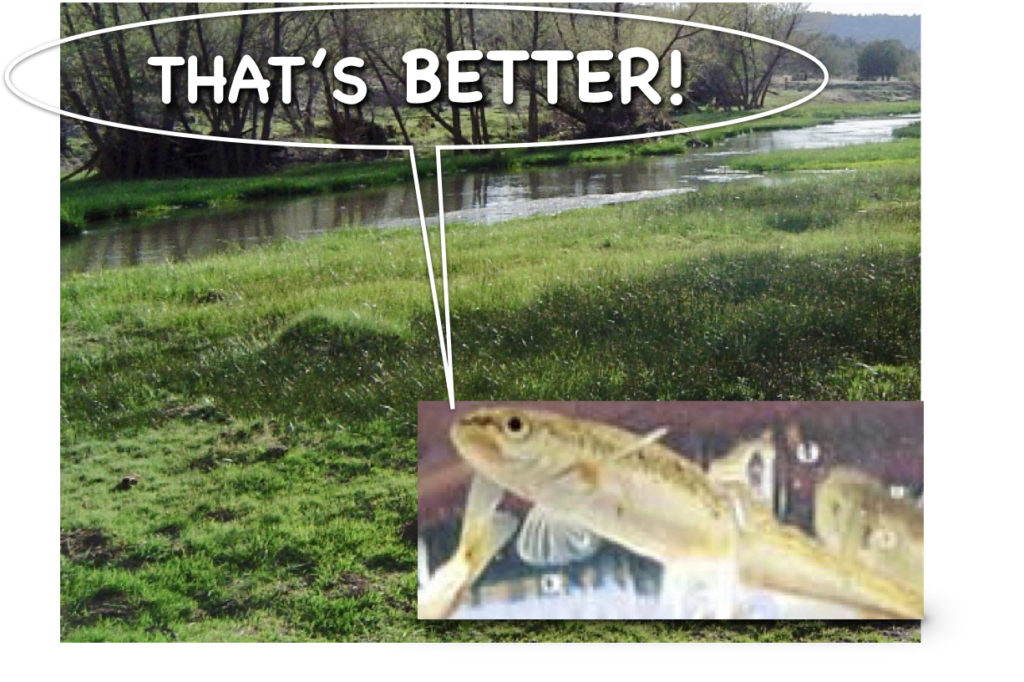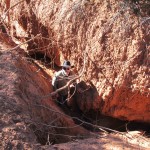

FIX THE PROBLEM!

When I turn on my TV these days more and more frequently I see ads for class action lawsuits directed at people who have used or been impacted by some product which they believe has effected them adversely. These ads say: If you’ve used or been subject to certain garden chemicals (weedkillers), over the counter meds, cosmetics (talcum powder), or such, add your name to the list of people seeking compensation and you may qualify to share in penalty payoffs that can total into the billions.
Well, get ready. Here comes a situation that I believe will provide an opportunity for a lot more people to join the class action crowd. Here in Arizona, the USDA Prescott National Forest, in cooperation with the Arizona Game and Fish Department and U.S. Fish and Wildlife Service, has initiated the National Environmental Policy Act planning process for the application of rotenone — ”a chemical substance toxic to fish,” to remove non-native aquatic species from a stretch of the Verde River, as well as a number of livestock watering ponds, and sections of some other rivers. (open to comments until 8/24/2020)
The problem is, rotenone which is commonly known as ”rat poison.” (”Piscicide,” by the way, means fish poison.) has been connected with Parkinsons Disease in humans via studies such as one dated February 2011 by the National Institute of Health (NIH). That study found that individuals exposed to rotenone (or a similar herbicide – paraquat) ”were roughly two and a half times more likely to develop Parkinsons Disease.”
So, why would government agencies add a substance that has been associated with something as serious as Parkinsons Disease into a river that flows through nearly two hundred miles of population-exploding Arizona and helps fill a reservoir (Granite Reef Dam) from which water is used for irrigation by the 5th largest urban area in the U.S.?
Ironically, the problem adding rotenone to the river is intended to solve is actually the result of a previous ”solution” these same agencies applied on the upper reaches of the Verde in the late 1990s.That’s when a couple of environmental groups threatened to sue the US Forest Service to remove livestock (cattle) from public land along the upper Verde because they claimed grazing was degrading the habitat and impacting a number of native fish species including a couple of 3 inch minnows legally designation as ”threatened” — the spikedace and loach minnow
Rather than arguing the matter, the U. S. Forest Service acceded to the groups’ demands out of court and completed removal of cattle from public lands along the river in 1997. While that solution was being applied it became apparent that the spikedace and loach minnows were being removed as well. In fact, the spikedace count dropped from 428 in 1994 to 0 in 1997, when grazing removal was complete. Notably, while this was happening, the number of other native fishes on this stretch of the Verde was dropping as well (from 80% native/20% nonnative to the opposite of that).
How did removing what was alleged to be the major threat to those fish—grazing—cause that to happen?
While the removal of livestock was being applied, U. S. Department of Agriculture scientists observed that a large increase in trees and willows began to crowd the riverbanks transforming the stream from wide, shallow, bordered by grassy meadows and warmed by the sun (ideal habitat for spikedace and other warm-water natives)…To narrow, tree-shaded, deep, mud-bottomed, and cool, which is ideal for non-native predatory fish such as flathead catfish and smallmouth bass.
And then the non-native big fish ate the native little fish!
As government scientists watched this unfold, the realization began to arise that the removal of cattle appeared to be making the Upper Verde less hospitable, even hazardous, to its natives. Based on this, the scientists hypothesized that grazing might have actually been sustaining some habitat characteristics that were vitally important to the spikedace and other warm water natives. They then took the logical step of proposing research into the matter.
This was not well received by others within the Forest Service who pressured the scientists proposing the grazing/native fish interaction research to back off.
22 years later (11/2019), a spikedace count along the still-protected Upper Verde revealed that spikedace numbers were still at zero. (and the designation of both minnows has been elevated to ”endangered.”) In spite of that, the people and groups that fought and worked so hard to remove grazing from along the Verde —allegedly to save the natives — continued to treat the move as a success, leading them to the conclusion that removing the non-native big fish via rotenone and restocking native little fish, which would no longer be endangered by introduced predators — now dead, would solve the problem.
The problem it wouldn’t solve, however, is that the habitat change that followed the removal of grazing — the increase in trees and willows that transformed the stream from wide, shallow, gravelly, and warm to narrow, deep, tree-shaded, mud-bottomed, and cool — would still be the case.
In other words, this section of the river would still be foreign to spikedace and other natives and home-sweet-home to any non-native predators that might venture there. That gives rise to the question: How long before treated sections of the river are re-invaded by predators and have to be re-fish poisoned?
Providing an alternative is the fact that, on the Gila River in New Mexico, federal and state agencies have taken a different tack with very different results. In a report dated 02/23/2012, the U.S. Fish and Wildlife Service stated that it had not removed grazing from along a certain section of the Gila because the land through which that section flowed was being managed in such an ecologically effective manner by the ranches which bordered it that, ”Portions of the Gila River and Mangas Creek in New Mexico (which continue to be grazed) support the largest numbers of spikedace in their range.”
In light of that, it makes sense to ask, has this revelation increased any inclination in the appropriate agencies to return grazing to the Verde to perhaps restore its habitat to the condition that made it spikedace and other native fish friendly?

- HERE’S THE GRAZED AREA IN 2019. A SECTION OF THE PROTECTED AREA ON THE SAME DAY IS SHOWN IN THE INSET.





